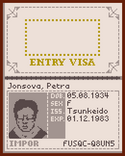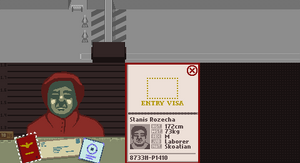
The first mockup picture of the game posted by Lucas Pope to the developer log.

The evolution of the interface. The first picture features a telex handle which evolved into a telex screen seen in the second and the third picture. It was later removed as seen in the bottom picture from the release version. The second picture shows the original hanging rulebook. The last three pictures are narrower because the desk to the right (not visible here) was made wider to make more room to move the documents around.
The development of Papers, Please spanned nine months[1] in 2012–2013. Lucas Pope first announced the name of the game in the developer log on the TIGSource forum on November 14th, 2012.[2] Information on this page is based on the aforementioned log and tweets by Lucas Pope.
Thematically, Papers, Please follows the dystopian setting already seen in Pope's earlier games, such as The Republia Times.
Papers, Please was written in Haxe and used the OpenFL engine until switching to Unity in 2023.[3] Mobile ports use C# and Unity.[4]
Platforms[]
The game was developed for OS X (now macOS) and Windows, with OS X being the native environment. During the development, additional ports were occasionally requested on Twitter. In May 2013, Lucas Pope announced that his release priority was:[5]
- PC/Mac
- Linux
- localizations
- iPad
- Android/consoles
The OS X and Windows versions were released on August 8, 2013. A Linux version along with support for the French, German, Spanish, Portuguese (BR), Italian, Japanese, and Russian languages was released on February 12, 2014.[6] IPad version of the game was released on December 12, 2014,[7] and PS Vita version in Europe and North America on December 12, 2017.[8][9] Versions for iPhones and Android phones came out on August 5, 2022.[10]
Interface[]
In initial screenshots, the inspector's booth only contained the counter, the weight indicator, and the lines on the back wall to determine the entrants' height. Later, a microphone and a telex computer handle were added. The microphone served the same purpose as it would later serve in the release version: it is used to view a transcript and ask further questions. The handle was used to request information from the central computer, a feature that would become automated in the release version (a results slip now prints out automatically when the fingerprint button is pushed). Both the microphone and the handle had a counter on them that showed how many different items could be accessed by using them. This feature was later dropped. The telex handle was also removed and a switch that controls the shutter now appears in its place.[11] The shutters were part of the initial plan to have more events inside the actual booth, such as an entrant pulling a gun on the inspector, in which case the inspector was expected to close the shutters quickly to save himself.[12] This idea was never implemented, and the switch serves no gameplay purpose at the moment.[12]
When a clock was added to the lower left corner, where it still appears in the release version, the weight indicator was moved next to it (where the bulletin holder appears now).[11] When the rulebook was first introduced, it was located in the lower right corner, where the weight indicator is now.[11]
Aside from the telex screen, the location of items in the booth as they appear in the release version has remained almost the same since the early build released around November 24, 2012.[13] The build features the weight indicator, the microphone, and the clock and date in their current positions. The rulebook holder has been moved to the left side of the microphone, where the official bulletin holder is in the current release. The shutter controller was added soon after and was visible in the early build released around December 15, 2012.[14]
The narrow slot that the entrants use to hand in documents was added around December to bypass the problem of documents appearing from nowhere when entrant gives them to the inspector. The slot was added after another workaround, an animated hand of the entrant, did not work out.[15]
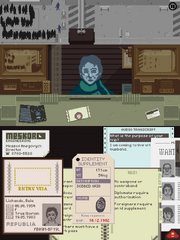
The iPad interface.
The iPad version of the game has a redesigned portrait interface where many of the features have been relocated. The booth also features two screens on both sides of the counter. They show the line of entrants and the right edge of the border zone but have no effect on the gameplay and are not used for anything. The iPad version can only be played in the portrait mode and rotating the tablet has no effect on the layout.

The PS Vita interface.
The PS Vita interface is similar to iPad interface, but without monitors, and back wall view covering a part of checkpoint overview when there's an entrant in the booth. Both checkpoint overview and back wall view can be scrolled with D-Pad, either of analog sticks or front touch screen. Additionally, L button is used for calling the next entrant, and R button is used for closing and opening booth's shutter.
Computer terminal[]
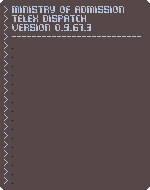
A template sheet the telex would print out after a query is still present in the assets of the latest beta version (0.5.13).
The basic functions of the telex handle (see above) were kept even though the handle was removed. In the later builds, the telex would appear as a separate computer screen in the booth, where the rulebook holder appears now. The display would have multiple screens, for example, one for the list of wanted criminals.[16]
The telex feature became obsolete after the introduction of the current fingerprint system (see below) and was removed.[17] The rulebook holder was moved from the left side of the microphone to its place.
The official bulletin was introduced to replace the non-interrogation-related features the telex previously handled. The current action buttons (search, fingerprint and detain) were also introduced to streamline the interface after the removal of the telex computer.[17]
Document handling[]
Document handling did not originally involve dragging. Instead, the player would click on the document on the counter and it would appear in the desk. This was changed early on to the current drag-and-drop system as the original concept would only allow documents to be 150 pixels wide and to have two of them visible at the same time.[18]
Initially, the stamped documents were returned by dragging all of them to the counter instead of actually giving them to the entrant, as in the release version.[17]
Stamps[]
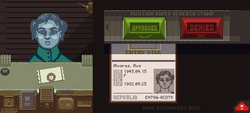
The initial stamp bar.
The original concept was to have the stamps on the counter where they would then be dragged to the desk. Since this felt unresponsive with the drag-and-drop interface, the current stamp holder that pulls out over the desk was implemented.[19] It looked slightly different than in the release version and could be used to stamp any document, not just passports. This was changed in the 0.1.1. build to avoid confusion and unnecessary stamping.[20]
The reason for denial stamp was added relatively late. During the beta, there was no incentive for the player to interrogate because they could just use the red stamp immediately when they detected a discrepancy (this is still the case in the release version until day 18). First, this was prevented by having the red stamp only become available after the inspector detects a discrepancy in the inspection mode. This felt too game-like, so it was eventually replaced with the current reason for denial stamp system.[21]
Inspection mode[]
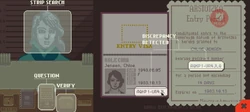
Early inspection mode that allows all investigation options upon finding a discrepancy.
In the early builds, pointing out a discrepancy in the inspection mode would enable the use of all possible investigation options the inspector has at his disposal. For example, finding two different names would allow the inspector to not only interrogate or take fingerprints but also to use the scanner.[22]
Fingerprint system[]
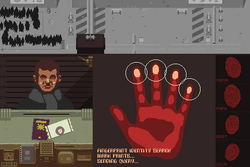
The initial fingerprint scanner
An early development version had a minigame-like fingerprint system with a futuristic scanning interface,[23] but it was dropped as it did not fit the overall 1980's theme.[24] It was replaced in early January with the current low-tech system that uses ink, paper, and a matrix printer.[25]
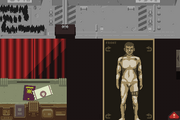
Strip Search at development version.
Weapons[]
The initial idea was to just include the tranquilizer gun, but a sniper rifle was implemented around early February, 2013. At the time, three options to deal with intruders were planned:[26]
- Do nothing and receive no bonus.
- Use tranquilizer gun, which is harder to aim and might need multiple shots.
- Use the sniper rifle, which would eliminate the intruder in one shot.
Using the weapons was deemed too easy, so different concepts to increase difficulty were planned. One of them was an aim-line from the booth instead of a crosshair.[26] The difficulty problem was solved by adding the current weapon system where the shooting itself is relatively easy, but the difficulty comes from having to use the key to unlock the drawer, open it, and pick up the gun before the player can eliminate an intruder.[27]
Confiscation[]
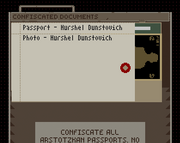
Image of a confiscated scanner photo as posted by Lucas Pope in the TIGSource forums.
Ability to confiscate passports was shown in the developer log on February 11, 2013.[28] Initially, the inspector also had an opportunity to confiscate searched entrants' nude photos which he could then sell for a small profit. Scanned images would remain in the booth and would be automatically moved to the confiscation drawer. The inspector could then pull them out to be sold during a scripted encounter. This feature was later removed since it devalued the dramatic importance of passport confiscation at the end of the game.[12]
Calling in the next entrant[]
Before the introduction of the current speaker system (click them on top of the booth), the next entrant would be called by clicking a small bell on the left side of the counter.[29]
Resolution and aspect ratio[]
The aspect ratio of the first mockups posted on TIGSource forums is 16:9. The ratio 3:2 was experimented with but that was later changed to 16:9 to give more room for document handling.[30] At this point, the game's native resolution was 570x320.
The original idea, according to Lucas Pope, was to vectorize all graphics to make them more appealing to potential customers and better suited for retina display.[31] Several options, including hqx, were toyed with, but the original pixelated look was chosen after consideration and positive fan input at GDC.[32]
Documents[]
In the original concept, the forged documents would differ slightly from the real ones by their layout, but since this seemed implausible,[22] the use of factual errors and forged seals was chosen instead.
One of the ideas mentioned in the developer log talks about the possibility of a "stamp arms race" between the M.O.A. and the counterfeiters: the seals would become more complex as the game progresses while the counterfeiters would try to keep up by offering more and more detailed forged seals.[22] Even a separate ultraviolet light to check seals was considered.[33][12]

The Arstotzkan Passport was changed two times before finalization.
The eagle that is used on all Arstotzkan paperwork was changed twice during the development: initially, it was just a large eagle portrayed in a relaxed ("close" in heraldic terms) stance up until Build 0.5.13 in which it was completely replaced with the current screaming eagle with both wings fully open ("displayed and elevated") and bearing the same shield that is used to represent the Ministry of Admission.
Passports[]
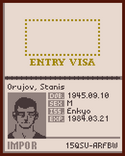
Imporian passport in the beta...
Initially, all passports looked the same, and they still appear very similar in the latest beta version. There were at least two ideas to make the citizen and their passports easier to distinguish. One was to divide up some of the facial features so that citizens of different countries would look different, but this idea was never implemented.[30] The other idea, color-coding, as suggested by TIGSource users, was eventually chosen and the data pages were made more distinct.[34]
There was also an idea to make the inspector check the previous visas the entrants have on their passports, but this was dropped during the development.[35]
Citations[]
In the early alphas, the citation system was not supposed to tell the player which error they missed, but this was changed[36] to let the player learn from their mistakes.[37] The citations in the release version are omniscient (the player does not know why the M.O.A. instantly knows when the inspector makes a mistake), but there were plans to have an actual overwatcher at work at the checkpoint.[12]

A red overwatcher light in the stamp bar of the beta version.
A reference to the overwatcher system is still visible in the stamp bar of the beta even though the actual system is not in use. A red light in the stamp bar would indicate when the overwatcher was at work, so to avoid a citation for breaking immigration protocol, the inspector would have to wait until this person leaves (i.e. the light turns off). The overwatcher was also going to appear in the storyline, and, with the inspector's help, EZIC would have eventually managed to put their agent into the overwatcher position. The light and later the entire concept of a tangible overwatcher were abandoned as they would shift the focus from moral quandaries to following orders.[12]
Initially, each citation would lead to a 5-credit penalty, but current escalating penalties for amassing citations were added to force the player to actually look at the documents before stamping them.[38]
Entrants[]
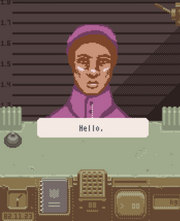
Early speech bubble. A bell used to call in the next entrant is visible on the left.
An early test build had entrants that could have at least four different errors in their documents.[13] Early builds also never featured entrants with valid papers in order to make the testing of inspection elements easy.[14]
The face generating system to procedurally generate different entrants was completed very early on.[39] The system in the release version uses 32 pre-made faces that were gradually added during the development.[19][40] Its inner workings are explained in article about photos. A timelapse of the drawing process is available on YouTube.
Initially, the speech bubbles would appear right below the entrants with a dashed line (similar to those in the current inspection mode) pointing towards the entrant. The lines said by the inspector would appear below them, with a dashed line pointing to the bottom of the screen towards the inspector. This was replaced with the current system of floating bubbles at the top of the booth view.[17]
The animated sprites of entrants in the top overview of the checkpoint were hand-drawn frame by frame and were then combined into one sheet using TexturePacker.[41]
The option to disable nudity was not originally planned but was added for practical reasons and after feedback.[42][33]
Name submission[]
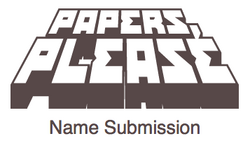
Title on the name submission page.
On March 12, 2013, Lucas Pope opened a form people could use to submit their information in order to have their name (possibly) appear in the game.[43][44] Three days later, over 70 people had submitted their names, but only 7 of them submitted a female name.[45] By March 25, over 1,000 names had been submitted[46] and by April 14, the number of submissions had grown to 2,000.[47] The submission was eventually closed on May 31 after over 27,000 names had been submitted.[48][49][50]
Out of these names, 5 642 were randomly drawn and manually inspected. Then 2 705 complete names were selected to appear in the release version.[51] Upon the original release, the game still contained copyrighted and inappropriate names, many of which were removed in later patches.
Finances and progression[]
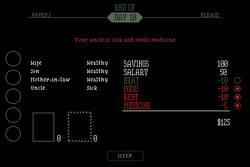
The first picture of the night screen as posted by Lucas Pope in the TIGSource forums.
The finance system was added to give the player a sense of progression and an incentive to not outright deny all entrants with invalid documents.[52] The initial concept was to include "wealth brackets" that would change according to the inspector's income level. This idea later transformed into different apartment classes in the release version.
The performance of the inspector was supposed to be reported by the M.O.A. via letters (see below) whereas the inspector's personal life would be managed in a nightly screen (as in the release version). This screen was first shown in early January, 2013[53] and was playable in the beta 0.5.5. released on March 13, 2013.[20]
The Truth of Arstotzka and the Official Bulletin[]
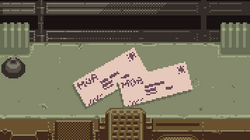
M.O.A. letter mockup concept that preceded the Official Bulletin and The Truth of Arstotzka.
Early on, there was a concept of tracking the performance of the inspector by showing a summary of his actions and their consequences at some point, not necessarily right after each day.[29] One of the proposed ideas was a stack of letters that would be waiting the inspector on his desk at the beginning of the day.[52] As the current fingerprint system was introduced and made the telex computer screen useless, an official bulletin was introduced to convey some of the information previously handled by telex (the wanted list).[17]
The idea of adding a newspaper that would be thematically similar to The Republia Times was presented on the TIGSource forum on February 6, 2013.[54] Lucas Pope liked the idea of using truncated headlines to avoid excessive written exposition,[55] so the letters were dropped, and The Truth of Arstotzka was presented in the developer log about two weeks later.[56]
Story[]
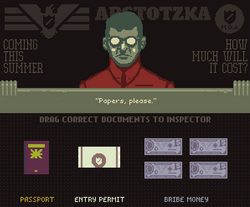
The mini game for the price announcement was based on an abandoned concept of an escape to Obristan. The game contains a picture of an Arstotzkan inspector that is sometimes used to depict the protagonist of Papers, Please although no connection between the two is established in either game.
The story mode of Papers, Please currently has 31 playable days. The original concept was to have only 30 days, but an additional day was added to fit all the storylines[57][21] and make it easier to motivate each newly introduced gameplay mechanic with some sort of story element.[58] The story would have lots of short threads (1–3 encounters), 2 or 3 longer stories, and one storyline that would span across the entire game.[59]
Most of the storylines were planned out by May 9, 2013 and were later arranged across the 30 days of gameplay.[60] According to Lucas Pope, the idea was to front-load interesting elements to hook the player, expand long stories in the middle, and build up tension for the climax.[60]
At one point during the development, the inspector's escape to Obristan (endings 16 and 18 in the release version) involved a mini game where the player would have to play through an immigration procedure sequence but through the eyes of an entrant. They would need to wait in line and give the documents and a certain amount of money to the Obri inspector in order to make it to Obristan. This feature was eventually cut as it would have placed more emphasis on these particular endings and would have forced the player to replay day 31 had they failed the mini game.[61] Later, the same concept was used in a mini game that revealed the price of the release version. It can be played at http://papersplea.se/pricegame/.
Sounds and music[]
- Main article: Sounds and music
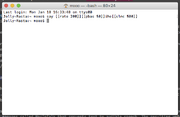
Entrants' voice reproduced using the command say in OS X Terminal.
Similar to fonts used in the game, the sound effects are based on public domain sources. Sounds from freesound.org and soundsnap.com were used but have been further edited.[30] Sound effects were first shown to the public in the beta 0.5.5. released on March 13, 2013.[20]
The voices for characters were done with the OS X command line tool say, a built-in speech synthesis manager called MacInTalk that converts text to audible speech. The resulting voices were then edited in Audacity and GarageBand.[62]
The theme song was made with a Yamaha MOX6 synthesizer[63] and was published on YouTube on January 14, 2013.[64] The sheet music was published by Lucas Pope on Twitter,[65] but has since been made unavailable (see renderings of the published pages: 1, 2, 3, and 4).
Modding[]
Early preview builds and the current beta version support mods. Mod support was also considered for the release version,[66] but was later dropped.[67] It may still be added later.[67][68]
Development timeline[]
- November 14, 2012 – The game is announced and a developer blog is created on TIGSource forums.[2]
- November 22, 2012 – The first build is released.[11]
- January 14, 2013 – Theme song is released on YouTube.[64]
- February 1, 2013 – Alpha 0.1.1. is released.[18]
- March 12, 2013 – Beta 0.5.5. is released.[36]
- April 11, 2013 – Steam Greenlight page is set up. Trailer is finished.[69]
- April 14, 2013 – Beta 0.5.7. is released[70]
- April 27, 2013 – Beta 0.5.13 is released.[71] This is the latest beta version currently available at dukope.com.
- May 2, 2013 – Papers, Please gets Greenlighted on Steam Greenlight.[72][73]
- June 2, 2013 – Lucas Pope registers the domain name papersplea.se.[74]
- June 4, 2013 – A mini game for announcing the price of the final version is released.[75] The game contains an alleged picture of the inspector who would only appear in the family photo in the release version.
- June 23, 2013 – The development reaches the point where the game can be played from start to finish.[76]
- August 1, 2013 – The game becomes available for preorder.[57]
- August 5, 2013 – The game needs to be ready for the release.[57]
- August 8, 2013 – The game is released on Steam, gog.com and on the official site (via Humble store).
- October 11, 2013 – Lucas Pope says he is working on localized versions for French, Italian, German, Spanish, Japanese, Korean and possibly Russian.[77]
- February 12, 2014 – Version 1.1.60 is released. It adds support for Linux version and French, German, Spanish, Portuguese (BR), Italian, Japanese, and Russian localizations. The update also contains a software rendering mode.[6]
- July 4, 2014 – Support for Steam trading cards was added.
- December 12, 2014 – IPad version is released.[7]
- December 12, 2017 – PS Vita version is released.[8][9]
References[]
- ↑ http://twitter.com/dukope/status/438515472590336001
- ↑ 2.0 2.1 dev log post on Nov 14, 2012
- ↑ Version 1.4.9 - Engine Update
- ↑ dev log post on Aug 6, 2022
- ↑ http://twitter.com/dukope/status/331623448520556546
- ↑ 6.0 6.1 http://twitter.com/dukope/status/433662244371460096
- ↑ 7.0 7.1 https://twitter.com/dukope/status/542867852584161280
- ↑ 8.0 8.1 http://papersplea.se/vita/release.html
- ↑ 9.0 9.1 https://twitter.com/PlayStation/status/940622982334111744
- ↑ https://twitter.com/dukope/status/1555585056449916929
- ↑ 11.0 11.1 11.2 11.3 dev log post on Nov 22, 2012
- ↑ 12.0 12.1 12.2 12.3 12.4 12.5 dev log post on Nov 11, 2013
- ↑ 13.0 13.1 dev log post on Nov 24, 2012
- ↑ 14.0 14.1 dev log post on Dec 15, 2012
- ↑ dev log post on Dec 29, 2012
- ↑ second dev log post on Nov 22, 2012
- ↑ 17.0 17.1 17.2 17.3 17.4 dev log post on Jan 19, 2013
- ↑ 18.0 18.1 dev log post on Feb 1, 2013
- ↑ 19.0 19.1 dev log post on Dec 12, 2012
- ↑ 20.0 20.1 20.2 dev log post on Mar 13, 2013 Cite error: Invalid
<ref>tag; name "mar-13" defined multiple times with different content - ↑ 21.0 21.1 dev log post on Nov 19, 2013
- ↑ 22.0 22.1 22.2 dev log post on Dec 8, 2012
- ↑ dev log post on Jan 3, 2013
- ↑ dev log post on Dec 5, 2012
- ↑ dev log post on Jan 6, 2013
- ↑ 26.0 26.1 dev log post on Feb 12, 2013
- ↑ dev log post on Apr 18, 2013
- ↑ dev log post on Feb 11, 2013
- ↑ 29.0 29.1 dev log post on Dec 17, 2012
- ↑ 30.0 30.1 30.2 dev log post on Feb 8, 2013
- ↑ dev log post on Mar 16, 2013
- ↑ dev log post on Apr 2, 2013
- ↑ 33.0 33.1 dev log post on May 5, 2013
- ↑ dev log post on Mar 17, 2013
- ↑ dev log post on Apr 24, 2013
- ↑ 36.0 36.1 dev log post on Mar 12, 2013
- ↑ second dev log post on Mar 17, 2013
- ↑ dev log post on Apr 24, 2013
- ↑ dev log post on Nov 26, 2012
- ↑ dev log post on Mar 20, 2013
- ↑ dev log post on Feb 14, 2013
- ↑ second dev log post on Apr 23, 2013
- ↑ second dev log post on Mar 12, 2013
- ↑ http://twitter.com/dukope/status/311681080438710275
- ↑ http://twitter.com/dukope/status/312449334610370560
- ↑ http://twitter.com/dukope/status/316079039972515840
- ↑ http://twitter.com/dukope/status/323287727665717248
- ↑ http://twitter.com/dukope/status/338863175342637057
- ↑ http://twitter.com/dukope/status/325126586351362049
- ↑ http://twitter.com/dukope/status/361954399179902976
- ↑ http://dukope.com/usemyname/
- ↑ 52.0 52.1 second dev log post on Dec 17, 2012
- ↑ dev log post on Jan 9, 2013
- ↑ dev log post on Feb 6, 2013
- ↑ second dev log post on Feb 6, 2013
- ↑ dev log post on Feb 22, 2013
- ↑ 57.0 57.1 57.2 dev log post on Aug 8, 2013
- ↑ dev log post on Nov 6, 2013
- ↑ dev log post on Feb 27, 2013
- ↑ 60.0 60.1 dev log post on May 9, 2013
- ↑ dev log post on Nov 18, 2013
- ↑ http://twitter.com/dukope/status/378706405517049856
- ↑ http://twitter.com/dukope/status/364803278011240449
- ↑ 64.0 64.1 dev log post on Jan 14, 2013
- ↑ http://twitter.com/dukope/status/348371638246580224
- ↑ dev log post on Apr 22, 2013
- ↑ 67.0 67.1 http://twitter.com/dukope/status/366656590062948352
- ↑ http://twitter.com/dukope/status/370417096020070400
- ↑ dev log post on Apr 11, 2013
- ↑ dev log post on Apr 14, 2013
- ↑ dev log post on Apr 27, 2013
- ↑ http://steamcommunity.com/sharedfiles/filedetails/updates/138290904/1367484593
- ↑ dev log post on May 2, 2013
- ↑ http://twitter.com/dukope/status/341200147851669504
- ↑ dev log post on Jun 13, 2013
- ↑ dev log post on Jun 23, 2013
- ↑ dev log post on Oct 11, 2013

